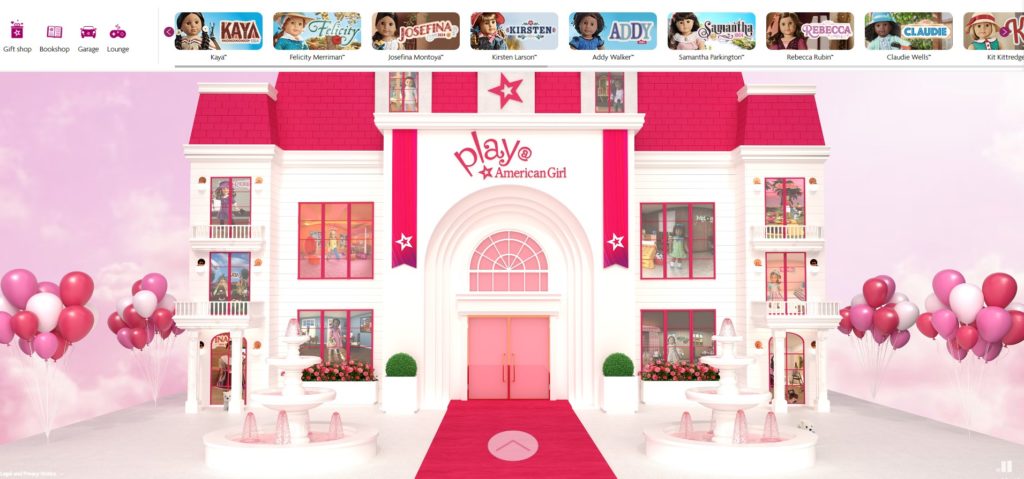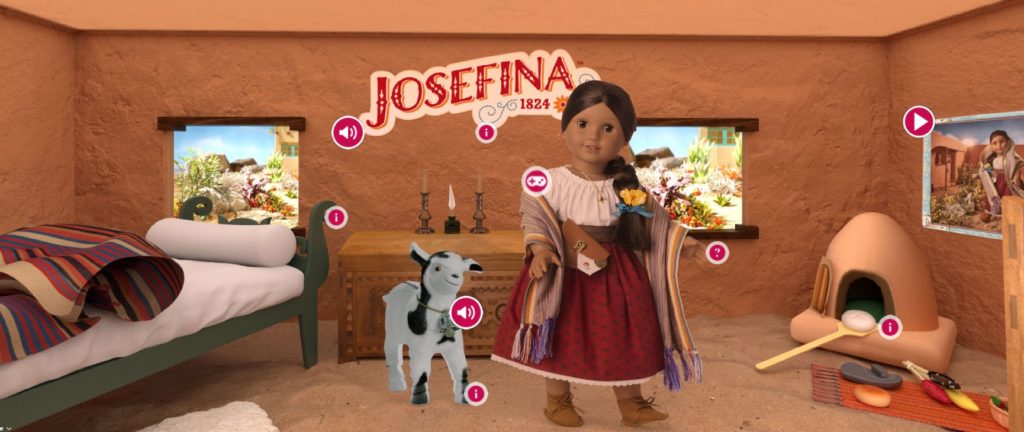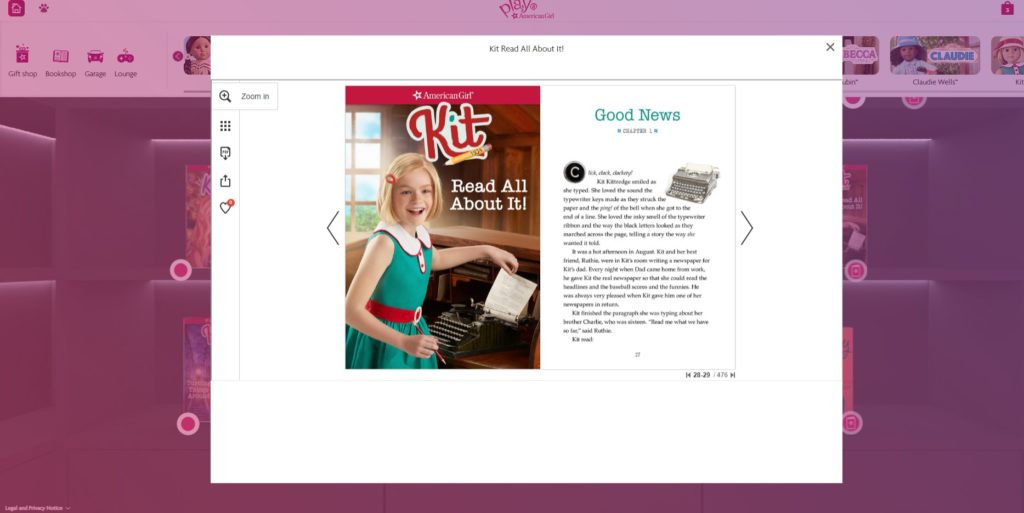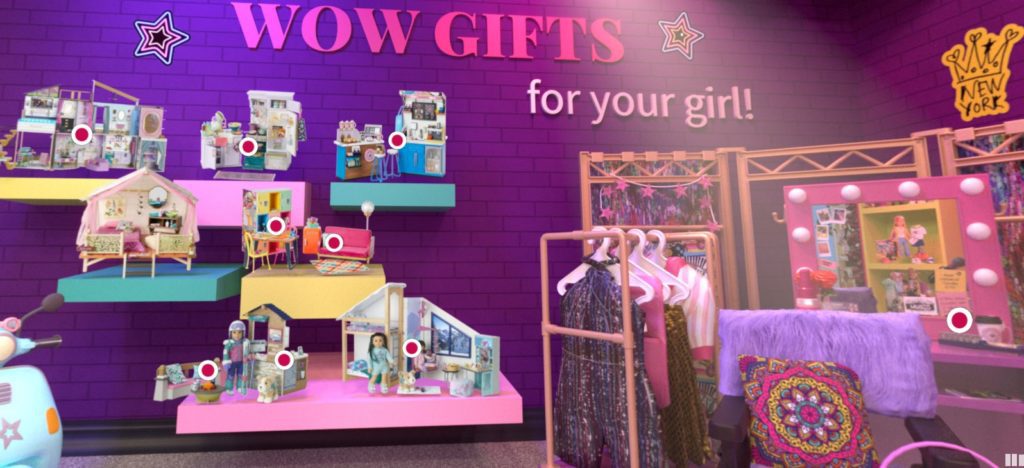Engaging content is a key component to loyalty at direct-to-consumer brand American Girl.
And it works. Shoppers who visit American Girl’s interactive virtual museum have a 25% higher add-to-cart ratio on its ecommerce site than shoppers who have not interacted with the museum, the brand says.
Since American Girl’s launch in 1986 as a cataloger, the brand has created a world around its doll products. For example, each doll is the leading character in her own period-set book series. This historical narrative helps keep children engaged with the brand and want to purchase not only the doll but also all of her matching accessories, says Debbie Haag, vice president of marketing at American Girl.
“We’re not just a toy. We’re not just a doll,” Haag says about American Girl’s main differentiator as a brand.
In keeping with the times, American Girl launched a virtual museum as another way to immerse consumers into the brand in a content-rich way.
“We were built on rich stories and experiences, and so the decision was really easy to create a virtual museum,” Haag says.
The virtual museum is an interactive website akin to how a consumer would use “Street View” on Google Maps. Consumers see the front of the museum and can click on icons to travel throughout the museum.

Pictured is the front of the American Girl virtual museum, which is geared for girls to engage with the different characters.
Each doll has her own room in the museum, which is decorated in a historical time period that correlates with the doll’s story. Consumers can click on different parts of the room to learn more about the character or her family, take a quiz about the doll or play a game.
“Through this immersive experience, the kids can feel a part of each character’s world,” Haag says.

Each American Girl doll character has her own time-period set room at the virtual museum. Here, doll Josefina is in her 1824-themed room.
Because American Girl’s focus is on stories and content, the brand made sure to create a bookstore in the museum populated with the brand’s books. There, consumers can find different books on the virtual shelves, click on them and read a preview of the first chapter.

The American Girl museum includes a book shop where girls can read the first chapter of any book.
Engaging content is part of the American Girl brand
The interactive museum is a complement to American Girl’s 11 physical stores, which are also meant to be interactive. For example, stores have a salon and doctor’s office for the dolls, and a restaurant where children and their dolls can have tea.
“If you are not in the locations of those 11 stores, you don’t get that immersive experience. We wanted to make it available for our fans,” Haag says.
American Girl launched the virtual museum in July 2021 after building it over the course of three months with technology vendor Obsess. In June 2022, it relaunched the museum as a “play destination” and incorporated a gaming component into it. In each room, there is a pet. If the girl finds all the pets, she earns points that she can redeem for a digital download.
Whenever American Girl launches a new doll character, it then refreshes the virtual gift shop with items for that doll. At the end of December, American Girl just launched its new girl of the year for 2023, Kavi Sharma. And so, the museum now includes a room for her and the gift shop is focused on products that complement her character.

The American Girl gift shop at the virtual museum.
This refresh of the museum coexists with its “omnichannel approach to marketing” in which American Girl will promote the doll on its website homepage, with in-store signage, on its social media platform, in addition to the museum.
Measuring success of the American Girl virtual museum
The virtual museum is a separate website URL — museum.americangirl.com/play —than the shopping-focused AmericanGirl.com ecommerce site. Consumers can navigate to the museum by hitting the “play” button at the top of the American Girl homepage.
“One site all about play and exploration and fandom, and AG.com is much more shopping focused,” says Stacy Carpenter, senior manager of user experience and user interface at American Girl.
Within the museum, a girl can create a wish list and then send that list via email to her parent or “gift giver,” Haag says. Because the target audience for American Girl is girls ages 5 to 10 years old, the brand legally cannot sell to them. Consumers can add items to their cart, but the products don’t have price tags on them. Girls also have to first enter their birth date before any items can be added into the cart, and only shoppers older than 13 can add to cart.
Because of these age-selling restrictions, the brand measures success in different ways for the museum website. Instead of focusing on add-to-cart and conversion — which are the key performance indicators for its main ecommerce site AmericanGirl.com — the virtual museum focuses on:
- Time spent in rooms
- Number of products clicked on
- Number of interactive points each girl earns with the provided games
- Number of items each girl adds to her wish list
And the museum pulls in the metrics to prove its worth, Haag says. Girls spend six to 10 minutes on average per session at the museum. That is 1,000% longer than average time spent for all shoppers on AmericanGirl.com, Carpenter says.
In the museum’s 18 months of existence, girls have added “thousands” of items to their wish lists, Carpenter says. Plus, those emails have a high conversion rate, on par with the rate of an abandoned cart email from AmericanGirl.com, Haag says without revealing figures.
It makes sense that the wish list emails have a high conversion, as the message is a tailored list of products from a loved one, Haag says. This strong performance is good, she says. It’s a lot less expensive to generate a conversion from a repeat buyer compared with acquiring a new customer, she says.
Plus, shoppers who visit American Girl’s interactive virtual museum have a 25% higher add-to-cart ratio on AmericanGirl.com than shoppers who have not interacted with the museum, the brand says.
American Girl is a premium brand, as it costs more than $100 doll. Because of this high-ticket order, on average, it takes five to seven touchpoints with the American Girl brand before making a purchase, Haag says. And that’s why having rich content is worth investing in, as it is another interactive element with the brand, Haag says.
“We know for a fact it is an important part of the journey,” Haag say.
American Girl chooses Obsess for virtual museum
The toy brand chose virtual store platform Obsess to build the virtual experience. American Girl was impressed with the Obsess founder and CEO Neha Singh, who previously worked at fashion magazine Vogue and had eye for fashion and premium brands, Haag says.
“She just had a great eye for detail and creating beautiful experiences,” Carpenter says.
Haag says the vendor was relatively new when they started work together. It felt like American Girl got a good deal for what it provided, Haag says without sharing a dollar figure.
“We’re a premium company, and we trusted them with our brand,” Haag says.
Obsess says its pricing depends on the size and complexity of each virtual store.
“The primary value of virtual shopping experiences is to allow brands to create deeper connections with its customers through increased engagement,” Singh says. “Virtual stores are particularly impactful in increasing brand equity and loyalty amongst young consumers.”
Obsess has built virtual experiences for several retail brands including Christian Dior, Ralph Lauren, Coach, Crocs and others.
Toy manufacturer Mattel, No. 203 in the Digital Commerce 360 Top 1000, owns American Girl.
Favorite